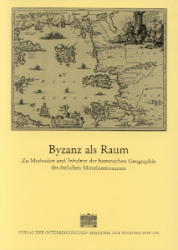
Bei dem 1966 initiierten Projekt Tabula Imperii Byzantini geht es um die Erfassung und Darbietung der historisch-geographischen Gegebenheiten des Byzantinischen Reichs. Nun, wo das Kerngebiet dieses Reichs, nämlich die südliche Balkanhalbinsel, Kleinasien und der Ägäische Raum, zur Hälfte in Form von neun Textbänden samt zugehörigen Karten dargestellt wurde, erscheint es sinnvoll, eine Zwischenbilanz zu ziehen und über künftige Wege dieses Unternehmens zu reflektieren. Seit dem Beginn des Projekts haben sich die für die Bearbeitung der TIB relevanten wissenschaftlichen Disziplinen methodisch weiterentwickelt und inhaltlich differenziert. Dieser Umstand erfordert es, die so erweiterte Informationsbasis und die verfeinerten Methoden verstärkt für das Projekt zu nutzen. Deshalb wurde schon bei der Vorbereitung des Symposiums „Byzanz als Raum” (Dezember 1997) und bei der Auswahl der Referenten der Schwerpunkt auf Fragen der Methode gelegt. Die hier erstmals publizierten achtzehn Beiträge berühren sehr verschiedene Aspekte wie beispielsweise: regionale Chronologie als Quelle frühbyzantinischer Verwaltungsgeographie; Terminologie der spätbyzantinischen Verwaltung; byzantinische Bleisiegel als Quelle zur zivilen, militärischen und kirchlichen Verwaltung: die Zusammenschau schriftlicher Quellenbefunde mit den Ergebnissen von Archäologie, Paläoklimatologie und Paläozoologie und -botanik; Orts- und Flurnamen als topographische, klimatologische, wirtschaftliche und ethnographische Informationsträger. Weitreichende Erkenntnisse liefert auch die Erforschung von Produktionsstätten und Handelswegen keramischer Erzeugnisse. Die quantifizierende und flächendeckende Erfassung sämtlicher Bodenfunde bietet eine neue Basis für die Siedlungs-, Sozial- und Wirtschaftsgeschichte. Einige Beiträge schließlich befassensich mit der Erforschung einzelner Regionen wie Makedonien, Bithynien, Sizilien, Böotien oder Kleinlandschaften wie dem Territorium von Sagalassos oder Istlada.
…
The project Tabula Imperii Byzantini, which was initiated in 1966, deals with the exploration of the historico-geographical data of the Byzantine Empire. Now that approximately half otf the central areas of the empire (in the Balkan Peninsula, Asia Minor and the Aegean) have been presented in nine volumes with accompanying maps, it seems to be of importance to take stock and to reflect upon the development of the project in the future.
Since the beginning of the project the necessary relevant scientific disciplines have been developed methodologically and differentiated in terms of with regard to its their contents. These circumstances require the use of the now amplified basis of information and refined methods for the project. For this reason, in preparing the symposium “Byzanz als Raum” (“Byzantium as space”) as well as in choosing the speakers, emphasis was laid on questions of methods.The eighteen contributions published here for the first time touch upon very differentne aspects such as regional chronology as a source for the geography of Protogbyzantine administration, terminology of late Byzantine administration, Byzantine lead seals as a source for civil, military and ecclesiastical administration, the combination of written sources with the results of archaeology, palaeoclimatology, palaeozoology and palaeobotany, toponyms and micro-toponyms as a basis of information for topography, climatology, economy and ethnography. Great advances in scientific knowledge were obtained have been made by the exploration of places of production and trade-routes of ceramics. The quantifying and space-covering comprehensive registration of all findings on the ground provide a new basis for social history as well as the history of settlements and economics. Some articles Finally, a number of articles deal with the exploration of selected regions such as Macedonia, Bithynia, Siciely, Beoetia or smaller geographical areas, e.g. the territories of Sagalassos and Istlada.
978-3-7001-2872-4
288 Seiten, 1 Faltplan,
broschiert, 29,7x21cm